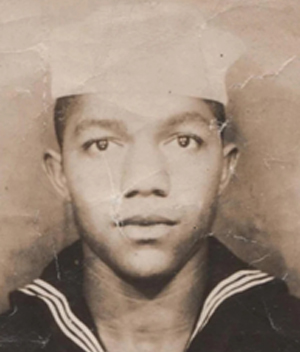"They Found Him”: Bringing Home a Pearl Harbor Hero
By Harrison Johnson
When the call came, Ms. Mary McCrimmon didn’t need a second to understand what it meant. “They found him,” she said. “They finally found him.” Her brother, Navy Mess Attendant 3rd Class Neil Daniel Frye, had been missing for more than 80 years—his name listed among the 105 sailors who died aboard the USS West Virginia on December 7, 1941, the day Pearl Harbor was attacked. But Neil Frye was more than a name. He was her brother. A boy who built sleds out of scraps for his sisters, and who left home when she was a preschooler to serve our country.
Now, thanks to the power of science, technology, and years of hard work, he has returned home.
A Face Among the Unknown
I’ve read more than 100 books about Pearl Harbor. I’ve studied names, ship logs, and timelines. But nothing prepared me for what it would feel like to sit across from a woman whose own brother died that day—and whose memories have been carrying him ever since.
In 2017, the Defense POW/MIA Accounting Agency (DPAA) exhumed remains buried as “unknowns” from the West Virginia. They were mixed together—meaning bones from more than one sailor had been placed in the same casket—and had been buried without names for over 75 years.
Dr. Freas, the forensic anthropologist who led Frye’s case, said identifying him was like putting together a jigsaw puzzle with no picture on the box.

Navy Mess Attendant 3rd Class Neil Daniel Frye.
“We don’t rely on just one piece of evidence,” she told me. “We used forensic anthropology, dental analysis, and DNA.”
But even DNA testing wasn’t enough. At first, they could only match two bones from Neil Frye’s left arm. That wasn’t enough to confirm a full identification. Other bones they suspected were his couldn’t yield DNA at all—they were too old and fragile. So the team turned to something called stable isotope analysis, a scientific method that reads the chemical makeup of bones to show where someone lived and what they ate. Everyone has a unique isotopic “signature.” When the team saw Frye’s same signature across other bones in different caskets, they were finally able to prove they belonged to the same person. That person was Neil Frye.

Harrison talking with Ms. McCrimmon
A Sister’s Watch
Ms. McCrimmon was only three years old when her brother left for war. She remembers little—just one clear moment when he kept her safe from the fireplace. But she always remembered how much her mother missed him.“She’d sit in the car and just watch people,” Ms. McCrimmon said. “She always thought maybe she’d see him walk by.”
I tried to imagine what that must have felt like—to always be looking for someone who never came home.
I had the honor of sitting down with Ms. McCrimmon in person for this interview. I traveled almost two hours to hear her story—and it’s one I’ll carry with me forever.
When the call came—that Neil had been identified—Ms. McCrimmon felt peace.
“I just said, ‘They found him.’ That’s all I wanted to know. That it was really him.”
My Reflection
I’m 12 years old, and I started Harrisons Heroes to honor those who served during Pearl Harbor. This is the most important story I’ve had the chance to tell.
Ms. McCrimmon looked at me and said something I’ll never forget: “You’re the first young person I’ve ever told all of this to.”
That meant the world to me.

Mary McCrimmon shares her memories of Neil during an in-person interview.

Harrison interviews Dr. Laurel Freas, the forensic anthropologist who led Frye’s identification.
SIDEBAR: How Science Brought Neil Frye Home
At the Defense POW/MIA Accounting Agency, science isn’t just used to explore the future – it’s used to heal the past.
Dr. Laurel Freas has worked on hundreds of cases, but she says Neil Frye’s was one of the most difficult. What made it possible was a mix of advanced technology and something harder to measure: determination.
Her team used four main tools to bring Neil Frye home:
- Forensic anthropology to study bones for age, height, and features
- Odontology to compare dental records
- DNA analysis to match remains to living relatives
- Stable isotope analysis, which measures chemical markers in bones to show where someone lived or what they ate
“Each of these on their own might not have been enough,” Dr. Freas told me. “But together, they brought the picture into focus.”
Stable isotope analysis helped confirm that bones buried in different caskets—separated for decades—were all part of the same person: Neil Frye.
Once the team had every piece of evidence in place, they presented it to DPAA leadership. Dr. Freas described it like a courtroom—laying out every step, answering every question, and proving the case.
When he was finally officially identified, they placed a ribbon on Neil Frye’s photo in the lab.
“It’s how we say, ‘We see you,’” Dr. Freas said. “You’re not unknown anymore.”
She also shared that this work is personal. Both of her grandfathers served in World War II, and she feels connected to the families she helps.
“This is my dream job,” she said. “Because it’s not just about science. It’s about making things right.”
Author’s Note:
I’m 12 years old and the founder of Harrison Heroes, which I started to honor the lives of those who served at Pearl Harbor and paid the ultimate sacrifice. I’m sharing this story around Memorial Day (2025) because Neil Frye’s name deserves to be known.
Writing this story had a big impact on me. Meeting Ms. McCrimmon and Dr. Freas, and learning how science and technology helped bring Neil home, showed me how powerful it can be when we use what we know to honor those we lost.